Marcel van Marrewijk's Blog, page 69
August 21, 2018
Finally, there is a way to measure significance!

For some years now, I am experimenting with value in my company Peer!, a Seats2meet location. It is a conference location and has an open structure. Everyone can walk in and work in the workspace, they pay in social capital, an example of this is sharing knowledge. The meeting spaces are paid for with monetary capital. Often other company owners ask me: ‘How is it possible to earn money if you give away your workspaces for free?’. I explain that it is not for free, the people that work with us also book meeting spaces, share their knowledge or tell their network about our location. Besides the normal monetary value, our location has a lot of social value and impact, but there was never a way to measure it. Finally there is a way to measure our social value and impact: the Scale of Significance!
Scale of Significance
The Scale of Significance is a new global instrument for the valuation of organizations. It originated at Manifesto, an innovative accountancy firm based in Amsterdam (The Netherlands). Now Manifesto is working together with a core team of experts, professionals and companies of various branches to develop this instrument. It will enable entrepreneurs, investors and clients to assess organizations based on a broad set of values, next to monetary valuation. In this blog I write what my dream is for the Scale of Significance, but it could develop quite differently, when all the experts and co-builders join forces to co-create the actual Scale of Significance.
How to measure significance?
The Scale is still in a developmental phase. I would like to share with you what I think is important to measure based om my experience from the past years in adding, creating and trading value:
It is important that an organization is transparent and practices what it preaches. In other words, the culture and identity of the organization should be aligned with wat the organization does and communicates.
The mapping of the flow of value in an organization is important: input and output of knowledge, products, services and collaborations. It visualizes the entire value of the organization and helps people to think in social value, next to monetary value.
What is the impact in the entire chain or ecosystem of the organization? Do they achieve the purpose they are aiming for or is there a negative impact, where the organization extracts value from its ecosystem?
I will expand on these aspects below.
Practice what you preach
There is a lot of attention for purpose and meaning in organizations. Rightly so, the public and customers no longer accept a company that claims to be – for example – environmentally friendly, but doesn’t practice what it preaches.
It starts with dialogue, with stakeholders, employees and other people and businesses in the ecosystem of the organization. Why was the organization created? What is the purpose of the organization? What can the employees do to add their own value to the purpose of the organization? Dialogue leads to consciousness and consciousness leads to change. If people feel the purpose of the organization and live to it, they will change the organization from the inside.
I see the Scale of Significance as a way of measuring the alignment between identity and practice on one side and communications and marketing on the other side. It is a way to measure the development of a consistent identity and off course a way to measure the progress or results.
Mapping the flow of value
An organization has an open or closed structure. For example, the Scale of Significance is developed by the crowd. Therefore the Foundation Scale of Significance is a very open organization and information flows rapidly into the organization. Knowledge and information going through the company can be seen as value. Next to these two, another type of value is collaboration. Collaborating with other organizations with common goals or interests, on a project that benefits both without invoices for the time spent adds value to both companies.
Spending more money on products that are sustainable and fairly produced also adds value to the company. Not only does it help the people that make the products you also contribute to a better world.
It is a different way of looking at costs and benefits and I say let us add these value flows to the income statement and balance sheet!
Impact
Impact is a really commonly used word these days. Don’t get tired of it yet, we are just starting! When does an organization have impact? An example of an impactful company is Tony Chocolonely. They dream of a slave free cacao production. When they succeed, they have the impact they strive for. How cool would it be if we can measure the impact? I hope there will be experts that know how to measure the total impact that is possible and how far an organization is in achieving said maximum impact. I think that these kind of goals are far more important than making financial profit. What kind of impact does an organization have that only acts for financial profit? None!
Measure value in other organizations
Based on my experience with value and significance in my own company, I’ve joined the Foundation Scale of Significance. I am enthusiastic to measure the value in other companies and help them to increase their significance and impact. We start by applying the Scale of Significance and make an actionplan together. Are you ready to change your (companies) way of thinking about value?
Ideas
I wonder if you have anything to add to my list of three ways to measure value in an organization. Please let us know! Think, build and develop with us. You can contact us with an email info@scaleofsignificance.org, reply below or join our Creathon on November 23th 2018 and forever change how the world thinks about value and significance!
The post Finally, there is a way to measure significance! appeared first on Seats2meet.
August 20, 2018
What is a coworker actually looking for in a space?

In my first blog post, I touched on different coworking operators and facilitators in the United States. Companies such as Level and Industrious are emerging in the market and competing against powerhouses such as WeWork. In my second post, I expanded on the coworking phenomenon by exploring where individuals cowork outside of a designated coworking space. Take your favorite local coffee shop or Starbucks for example, freelancers and digital nomads are drawn to such spaces because they are productive in them. With offerings such as free wifi, views of the outside and your favorite caffeinated beverage in hand, it is basically a recipe for success.
At the same time – with over 4,000 coworking spaces reported in the US in 2017, the amount of choices for a coworker appears to be quite daunting. And of course, aside from the official ‘coworking spaces’ there are thousands upon thousands of additional options to choose from. Cafes, libraries, local community centers, your home, the list can go on and on. With that in mind, how can you quite possibly choose? And, as a space operator: how do you position yourself to stand out from the endless competition?
One thing to keep in mind is, of course, not everyone is looking for the same thing in a space. While one person may prefer a space where they can do their work in collaboration with others, another may want a quieter space that is heavily equipped with technology. Nevertheless, several surveys have been conducted in an effort to understand what an individual looks for in a space to be their most productive self. Take remote workers as an example. According to the State of Remote Work 2018 conducted by Buffer, the biggest struggles of remote workers are loneliness (21%), collaborating and/or communicating (21%) and distractions at home (16%). In a sperate global survey conducted by Deskmag, the most important aspects of coworking spaces according to its users are interaction with other people, flexible working hours, and an environment that encourages serendipitous discoveries.
Taking this information into consideration, companies are able to better position themselves according to the expressed wants and struggles. However, do such companies really know what these users want? For example, what do remote workers mean by loneliness- do they simply want to be surrounded by other people yet remain undisturbed? Or, do they want to be provided platforms to network and socialize with others? Many of these questions remain unanswered. And since they remain unanswered, how can we verify that a space really meets the needs of its clientele?
With this in mind, I have created my own questionnaire aimed at digging a little deeper into the desires of coworkers. And please remember- coworking extends much further than the designated coworking spaces. Coworking is the use of an office or another working environment by people who are self-employed or working for different employers; typically, so as to share equipment, ideas, and knowledge. Thus, in keeping with my research which aims to understand how Seats2Meet should position itself in the American market, I have developed this survey specifically for Americans coworkers.
With that in mind, if you are a self-identified coworker who lives in the United States, I ask you to pretty please take my questionnaire! And if you are not from the US but have friends who are share with them! Not only does it take a short 5 minutes, but it will also help you think about what you are looking for in a space. It may also challenge you to consider if your current space is right for you and what could be done to improve the experience. And more importantly, the more research and information produced about what individuals are looking for in a space, the better-informed space facilities can be about what your needs are and how they can cater to them. It’s time to put the ball back in your court!
Follow the link to take the questionnaire: https://goo.gl/forms/c06uF7C9WIJoclMi2
The post What is a coworker actually looking for in a space? appeared first on Seats2meet.
PFL Utrecht Overvecht: een nieuwe nexus of forces met gave doe- en maakavonden
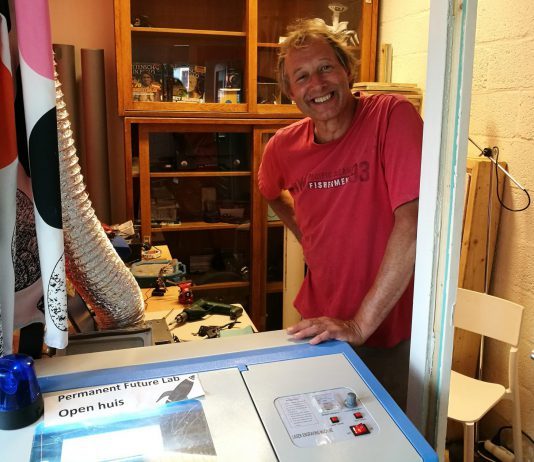
Na Apeldoorn en Oisterwijk, heeft Permanent Future Lab in Utrecht opnieuw haar laagdrempelige deuren geopend. Onder andere voor gave doe- en maakavonden! In een voormalig buurthuis in Overvecht. René, de organisator, is hier ook weer kantoor gaan houden.
In de transparante zaal, naast de kantine van Het Ondernemershuis, is nog een vergadering aan de gang, van – zo vermoed ik – ondernemers. En in de kantine prijkt, achter een bescheiden flatscreen met het dagelijkse doem- en dramanieuws, in roze en groene kleuren een spandoek met daarop de tekst: “Power by Peers: met eigen wijsheid samen ondernemen”.
Na een tweetal koppen eigengemaakte pompoensoep en een veelbelovende kennismaking met Geert, de beheerder van dit pand, komen de eerste echte ‘geeks’ al binnenlopen.
Nieuwe mensen, nieuwe ervaringen: een voorstelrondje 3.0
Ondanks dat het vanavond toch vooral niet praten, maar met de handen werken is, doen we eerst inloop in één van de zalen (lokaal 3). Helemaal achterin. Mensen kunnen dan rustig al hun hardware uitpakken, kennismaken en zich installeren onder het genot van een mok cholesterolneutrale filterkoffie.
Hoewel we met een man of 11 lijken te zijn, zijn er toch een paar nieuwe gezichten bij. En de achtergronden zijn al net zo zeer ervaren als zeer divers. Iedereen komt uitgebreid aan het woord om zich voor te stellen. Ook wel eens goed.
Op mijn introductie dat ik onder andere een beetje schrijf en investeer, reageert Jurjens vader links tegenover me stevig en adequaat met een Utrechts accent:
“Toch niet in Bitcoins??”
Het MORI Building Digital Art Museum
Beppy heeft daarnaast ook nog een zeer veelzijdige achtergrond. Dit varieert van politicoloog tot aan accelerator rollen bij onderwijstrajecten en van mantelzorger tot aan het opstarten van burgerinitiatieven als Gewoon Groeten. Bedoeld om sociaal gedrag in een wijk te bevorderen bij het uitlaten van je hond.
Nu wil ze een Japans museum voor digitale kunst naar Nederland (Zeewolde) gaan halen: Het MORI Building Digital Art Museum dat gevestigd is op het eiland Odaiba in ‘een speciale wijk’ in de baai van Tokyo. En dat niet al te lang geleden geopend is.
Hennep printen en het feit dat licht ook een geluid is
Daarnaast wil ze industriële hennep 3D gaan printen. En ze vertelt betrokken en honderduit over iets wat ‘het Lightning Initiative’ wordt genoemd en Het Theta Wellness Center. Een organisatie die zich bezighoudt met ‘Theta therapie’ om mensen in een ‘Theta state’ te brengen middels een ‘Theta Chamber’. Dit gebeurt door middel van een combinatie van geluid, kleine apparaatjes en ‘visual pattern light stimulation’.
Alles bij elkaar genomen doet het mij een beetje denken aan aan het relaxprofiel Reset, waar ik in september al eens dit artikel over schreef.
Zie voor reviews van gebruikers van de Theta Chamber ook deze korte video’s.
Overigens, ook de mogelijkheden voor het 3D-printen van huizen, of nog groter of opzienbarender, blijven niet onbesproken. Allemaal voor in woonwijken in Zeewolde. Om voor de bewoners een prettige leefomgeving te creëren.
PFL-locaties: toen, nu en… morgen?
Jurjens vader, al bij binnenkomst een papieren technologieblad bij zich geklemd, vertelt dat hij net met pensioen is gegaan. Hij heeft een LTS-achtergrond en heeft in het verleden zeer veel alarminstallaties gebouwd. Verder geeft hij aan dat hij aan het verhuizen is naar een dorp in de omgeving van Sneek.
Jurjen vervolgt met hoe hij het Permanent Future Lab op Utrecht CS heeft opgestart. Bij Seats2Meet. Hij legt uit hoe het Lab werkt, op basis van een ander waardesysteem. Dat we vrij technologie delen en intussen meerdere, verschillende locaties hebben, zoals op Bali en in Bangladesh.
“Misschien is Sneek ook een idee voor een Lab? Friesland valt immers ook onder het buitenland,” vragen mensen zich half serieus hardop af.
René vult aan. Hoe hij een Lab heeft opgestart op het terrein van de voormalige Zwitsalfabriek in Apeldoorn. Het organizonderen van onder andere DoDOdagen. En hoe verschillende concepten in die tijd werden opgestart, zoals de praatpaal – zie voor meer details de alinea ‘Ballenbakcomplex’ hier – en Meetjestad.net. Hoe de (geruisloze) verhuizing naar Oisterwijk kwam en het Lab nu weer verder is gegaan op Utrecht Overvecht.
Tree of Ténéré
Ook Nick van Breda is tijdens deze uitgebreide voorstelronde aangeschoven. Hij vertelt over Plan Einstein: een project dat hier in Utrecht plaatsvindt om vluchtelingen nieuw perspectief te geven. Een project ook dat al de aandacht van de media en van de internationale politiek heeft getrokken. Hij woont ook met deze vluchtelingen samen. Het initiatief loopt echter zeer binnenkort af, waardoor hij gaat verhuizen naar Almere.
Er komt waarschijnlijk nog wel een tweede variant op Plan Einstein ergens in 2019.
Nick heeft ook een drietal 3D geprinte, plastic bomen met LED-verlichting in verschillende kleuren bij zich. Hierover zal ik later op de avond van hem nog te horen krijgen dat het idee erachter vergelijkbaar is met de Tree of Ténéré. Bekend van Burning Man.

Meetup
“Ik ben benieuwd hoe jij deze Meetup gevonden hebt!”
Terwijl mijn buurman lang en druk op Internet op zoek is naar de oplossing, om een infraroodinstallatie op het toilet van 4 naar 10 elektrische groepen uit te breiden, ben ik even aan de andere kant gaan zitten.
Eén van de nieuwe gezichten vanavond is Jimmy. En René is nieuwsgierig naar zijn motivatie om hier te zijn. Ik heb in de wandelgangen al gezegd dat het platform Meetup gewoon heel goed is en echt werkt. Het heeft namelijk veel, zeg maar Facebook-achtige kenmerken, waardoor het snel en gemakkelijk heel bekend en populair is geworden.
Maar René wil echt een persoonlijk antwoord hebben. Al blijkt mijn verwachting al snel te kloppen:
“Ik ging naar meetup.com, omdat ik techniek interessant vind. Daarnaast houd ik me bezig met softwareontwikkeling en er zijn gewoon een aantal dingen gaande in de wereld, zoals VR, BlockChain, AI.. En als je geen afstand instelt op je profiel, krijg je zelfs meetups wereldwijd te zien. Tot in de USA.”
Jaap beaamt dit vanuit een ontspannen houding:
“Permanent Bèta, Gemeentes, Food Festivals.. je kunt elke week wat te doen hebben.”
Jimmy’s interesse in technologie is breed, diep en open. Zo liet hij eerder vanavond al weten zelf Kerstballen te gaan maken. Met een persoonlijke boodschap of muziek.
Keuken van robotarmen
Zijn zelfgebouwde project van voorgeprogrammeerde kentekenregistratie blijkt aan de RAI verkocht, hij is inmiddels afgestudeerd en heeft een baan gekregen bij Mansveld Expotech. Al blijft Tim zichzelf “de eeuwige student” noemen. En ook nu weer is hij met iets heel interessants bezig:
“Ik wil graag een 400V keuken bouwen die volledig door robotarmen bestuurd wordt. Op inductie, want dat vind ik fijner koken. De rekening van het stroomverbruik maakt mij daarbij weinig uit. Bij elektrisch koken kun je namelijk de temperatuur het beste op een gelijk niveau houden. Gas is onvoorspelbaar.”
Zijn standpunt hier verbaast mij. Qua denken in verduurzaming, kleiner wonen etc. waar ik nu al enkele jaren onderzoek naar doe, ben ik er juist helemaal van teruggekomen om het gas ooit nog te vervangen door elektrisch koken. Het gasverbruik bij koken lijkt mij, bij nader inzien, zeer minimaal als je het vergelijkt met de stevige hoeveelheid stroom die nodig is.
3D-printen: vlees en pannenkoeken
Het idee van het 3D-printen van hennep blijft mij bezighouden. Een soort o ja-moment: iets waar je niet verbaasd over bent, maar ook nooit bij stil hebt gestaan.
Tim is het er ook niet mee eens. Hij vindt het een beetje een achterhaalde technologie. En het risico is groot dat mensen met verkeerde bedoelingen worden aangetrokken.
Wel interessant vindt hij het 3D-printen van vlees. Hij heeft het zelf al eens geproefd. Er worden daarbij stamcellen uit vlees gehaald en dat gaat blijkbaar op zo’n geavanceerde manier dat het geprinte vlees naar eigen zeggen “fucking normaal smaakt”.
Tot op heden heb ik eigenlijk alleen gehoord over het 3D-printen van plastic, huizen en pannenkoeken. En vooral dat laatste heeft een bijzonder slechte (smaak)reputatie. Tim schiet van mijn reactie in de lach:
“Het enige wat je hoeft te doen is goed beslag maken. Ik ben daar zelf ook mee bezig.”
Geeky Night Out: the day after..
Het is op het moment van schrijven nog niet bekend wanneer de volgende avond bij Het Ondernemershuis zal zijn.
Net als vorige maand, hebben Jurjen en René deze tweede dinsdag tijdelijk even omgedoopt tot Geeky Night Out. Dit in verband met de zomerstop.
Aan het animo van de aanwezigen van vanavond zal het in ieder geval niet liggen: ik hoor voorstellen van wekelijks organizonderen, tot om de week.
De ‘reguliere’ Tech Tuesday staat gepland voor 11 september. Want ook daar is alle tijd, ruimte en gelegenheid om aan jouw eigen project te werken.
Geen copyright, maar copyleft
Dus heb jij nou zelf ook een technisch, technologisch of gecombineerd project, waaraan je graag verder wilt werken en bouwen, alleen mis je elke keer weer dat ene onderdeel, stukje expertise of samenwerking bij het uitvoeren ervan? En wil je weten waar je zelf ook allemaal nog bij aan kunt sluiten?
Laat je dan horen. En houd de Permanent Bèta Groep in de gaten.
De toegang voor deze avonden is vrij, want je betaalt niet met euro’s, maar met sociaal kapitaal. Dit betekent dat je je kennis, ontdekkingen en creaties deelt. Geen copyright, maar copyleft!
The post PFL Utrecht Overvecht: een nieuwe nexus of forces met gave doe- en maakavonden appeared first on Seats2meet.
August 17, 2018
⌂ STUDIO DRIFT ZOEKT ROTS IN DE BRANDING

STUDIO DRIFT IS HIRING: BEN JIJ DIE DAADKRACHTIGE CREATIEVE AANPAKKER?
Studio Drift is booming. Afgelopen weekend vlogen er 300 drones over het IJ in een algoritme gebaseerd op de vluchtpatronen van vogels tijdens de drukbezochte Europese première van FRANCHISE FREEDOM. Dit in navolging van de show tijdens de Art Basil in Miami vorig jaar. In het Stedelijk Museum is nog tot 26 augustus de solo show van Studio Drift te zien, CODED NATURE. Een overzichtstentoonstelling van het werk dat ze afgelopen 10 jaar hebben gemaakt, waarbij steeds de relatie tussen mens, techniek en natuur wordt onderzocht. Ook op plekken zoals de Parijs Fashion show en festival Burning Man zijn werken van Studio Drift te bewonderen. Hoogste tijd dus voor ondersteuning. Studio Drift is dringend op zoek naar een energieke, eigenzinnige, multi-inzetbare, doorgewinterde PA. Ben jij onze nieuwe rots in de branding?
Wat ga je doen?
Binnenkomend email-verkeer
Planning maken en bijhouden, afspraken inplannen
Directe opdrachten vanuit kunstenaars Studio Drift uitvoeren, productiewerk
Reizen boeken (veel internationale bestemmingen)
Contact opbouwen en onderhouden met art galeries en musea
Netwerk helpen opbouwen
Workflow en klantenadministratie bijhouden
Contact met Studio Drift optimaliseren, PR en communicatie
Aanwezigheid en mee reizen naar events
Wat vragen wij?
We zijn op zoek naar een echte aanpakker. Een zelfstandige, hardwerkende enthousiasteling die verder kijkt dan de 9 tot 5 mentaliteit en houdt van een dynamische omgeving.
Je hebt zowel affiniteit met de kunstwereld als de techwereld en een open blik.
Je legt makkelijk contact en vind het leuk om mee te werken aan het succes en imago van Studio Drift en kan dit ook goed overbrengen.
Full-time, dagen en tijden zijn bespreekbaar (evt. 4 dagen indien bereikbaar)
Je spreekt en schrijft zowel vloeiend Nederlands als Engels. Frans is gewenst.
Meer inspiratie op: http://www.studiodrift.com. Lijkt dit je wat, of ken je iemand?
Stuur dan snel een mailtje met een kort maar krachtige motivatie en je CV naar: ralph@studiodrift.nl
The post ⌂ STUDIO DRIFT ZOEKT ROTS IN DE BRANDING appeared first on Seats2meet.
August 16, 2018
Jugaad analytics is looking for a Business Developer
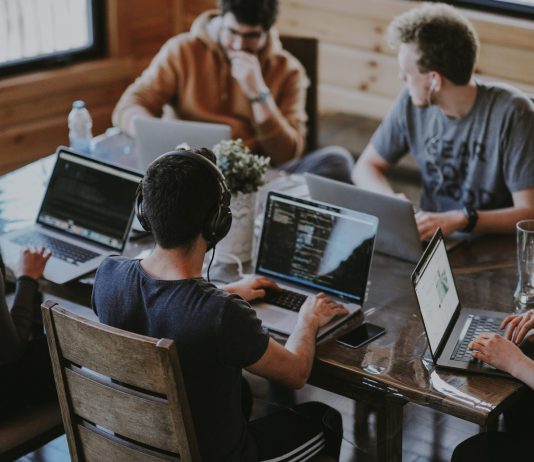 Job description
Job descriptionBusiness Developer (Oudebrugsteeg 9, 1012 JN Amsterdam)
Business students can also apply as an intern
Jugaad is a two-year-old tech start-up working in the field of predictive maintenance, and big-data analytics. We have an exciting team which processes the datasets in the back end and extracts business value and important insights for the customers. We are growing with respect to new and exciting projects. Hence, we are also growing as a team. We are looking for an exciting and likable person to join our team to develop and leverage our algorithms at customers, ranging from aerospace to FMCG industries. It is a great opportunity for somebody looking to bridge the gap between business and data analytics!
What are we looking for?
Skills and competencies:
Willingness to express his creativity on our team
Interested in learning by doing, and asking questions when in doubt and disagreement
Lead or guide workshops at customers
Understanding of (business) Innovation Canvas and other innovation tools
Affinity to improve engineering processes
Affinity with big data analytics and Industry 4.0
0 – 2 Year of experience
Preferably a background in a combination of Innovation and Engineering.
Social competences
Entrepreneurial and calculated risk taker
Willingness to learn and expand his horizons
Interested in understanding the value of data for clients
Proficient in English language and basic Dutch would be a plus
Availability to work independently in a team, i.e. be able to express himself
An ability to explain his work to the team of data-scientists and to manager
What do we offer?
Free lunch, coffee, and a work-laptop
Detailed experience of the limitations of AI today
A competitive fixed salary, complemented with bonuses based on company targets and personal targets
The possibility of representing Jugaad at conferences related to your topic in Europe
A beautiful neighborhood in Amsterdam to work from with an exciting and young international team
If internship: Possibility to have a permanent contract at the end of the internship
The post Jugaad analytics is looking for a Business Developer appeared first on Seats2meet.
Jugaad Analytics is looking for a Data-scientist
 Job description
Job descriptionJugaad is a two-year-old start-up working in the field of predictive maintenance, and big-data analytics. We have an exciting team which processes the datasets in the back end and extracts business value and important insights for the clientele. We are growing with respect to new and exciting projects. Hence, we are also growing as a team. We are looking for an exciting and likable person to join our team to develop our algorithms for predictive maintenance further.
What are we looking for?
Skills and competencies:
Willingness to express his creativity on our team
A good understanding of Pumps, Compressors, and Turbines
Intermediate knowledge coding and machine learning modules in Python
Interested in learning by doing, and asking questions when in doubt and disagreement
Social competences
Entrepreneurial and calculated risk taker
Willingness to learn and expand his horizons
Interested in understanding the value of data for clients
Proficient in English language and basic Dutch would be a plus
Availability to work independently in a team, i.e. be able to express himself
An ability to explain his work to the team of data-scientists and to managers
What do we offer?
Free lunch, coffee, and a work-laptop
Detailed experience of the limitations of AI today
Possibility to have a permanent contract at the end of the internship of 9 months
The possibility of presenting your work in 2 conferences related to your topic in Europe
A beautiful neighborhood in Amsterdam to work from with an exciting and young international team
Apply at Jugaad Analytics
The post Jugaad Analytics is looking for a Data-scientist appeared first on Seats2meet.
August 8, 2018
Seats2meet Reaches Milestone of Making Half a Million Co-Working Space Bookings
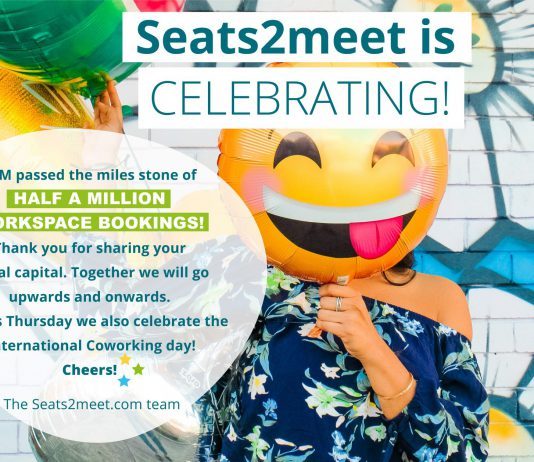 Following the recent release of the S2M Passport, the co-working company Seats2meet is celebrating an incredible milestone. The platform has now been utilized to make half a million workspace bookings.
Following the recent release of the S2M Passport, the co-working company Seats2meet is celebrating an incredible milestone. The platform has now been utilized to make half a million workspace bookings.As the modern concept of the workplace continues to change before our very eyes, a growing number of entrepreneurs, startups and professionals have utilized co-working spaces to connect with like-minded people and develop groundbreaking ideas and products. The Dutch co-working platform Seats2meet has played a critical role in cultivating this newfound global work environment.
After spending over 10 years working to make the co-working ecosystem more efficient and accessible to all, Seats2meet has just recently reached a truly triumphant milestone. The company is proud to announce that the Seats2meet platform has been used to make over half a million workspace bookings since the last update in 2014. The timing of this achievement was impeccable, as it was accomplished during the very same week as International Coworking Day–which takes place on August 9th.
Initially founded by Ronald van den Hoff and Marielle Sijgers in 2007, the Seats2meet journey started in one of the world’s first-ever coworking spaces, which was located in Utrecht. Since then, the platform has spread to 208 locations across 30 different countries. The success of the platform can be attributed to the franchise model concept that Seats2meet has championed. The ecosystem is not limited to any S2M location or specific country, but instead can be adopted by any co-working space owner throughout the globe.
Although Seats2meet currently has its largest presence in the European market, the company is planning to expand further into North America, Asia and Africa starting next year, aiming to reach over 1,000 co-working locations by 2020.
In order to take the co-working revolution one step further, Seats2meet recently unveiled the S2M Passport, a platform where users can manage their personal data, make reservations and bookings, gain full access to the S2M Ecosystem, increase their social capital and connect with other professional in the coworking network.
The S2M Passport encompasses that overall mission of Seats2meet, which is to create flexible workspaces that provide traditional location management and introduces the concept of social capital to the professional co-working realm.
While the Seats2meet team is certainly thrilled to reach the milestone of hosting 500,000 workspace bookings, that number is expected to grow as more professionals adopt the S2M Passport into their businesses. As the company continues to serve on a daily basis more than 200 locations worldwide and a network of over 60,000 professionals, the ongoing global expansion strategy will eventually take Seats2meet to the next milestone in the near future: to reach 2,000,000 meeting seat bookings!
 Image by Kelvin Tuin via Seats2meet
Image by Kelvin Tuin via Seats2meetAbout Seats2meet: Seats2meet is a Dutch coworking organization that creates online coworking tools that are inspired by the philosophy of Society 3.0. Products and services are created to provide a virtual space for people to connect, work together and share knowledge. In 2007, the S2M coworking ecosystem started with just 20 freelancers. Since then, it has expanded to more than 200 locations worldwide with 60,000 professionals that offer thousands of distinct skills between them.
Centered around the Passport, S2M tools function as an online booking platform for meeting-, cowork- and office space in exchange for social capital and/or monetary capital. The platform aims to connect people based on their shared interests and field of work, enabling users to request help from the vast coworking ecosystem.
The S2M coworking ecosystem is operated through a network of locations and a diverse group of coworkers, all of whom have specialized skills that can be utilized by other members. Thus, the mission of S2M is to link professionals with one another so that they can support themselves and each other through collaboration and contribution.
The post Seats2meet Reaches Milestone of Making Half a Million Co-Working Space Bookings appeared first on Seats2meet.
August 7, 2018
Help us improve the S2M Passport on Feedback Friday!

Recently we launched the S2M Passport, the place where user can manage and access the entire S2M ecosystem. Because we adopt the lean model we launched it as quick as we could so everyone could start enjoying its many benefits and opportunities. That also means that we are still working on it, and what a better way of knowing what to do next by asking you, the user?
How to test?
We host the Feedback Friday at Seats2meet Utrecht CS every Friday. It only takes 15 minutes and to do it just ask in the reception or e-mail nynke@seats2meet.com.
But wait! You can test it remotely too. It’s super simple:
Download the app Participate if you are going to test it on your phone, or download the Chrome extension if you are on your desktop.
Start testing! Go through the website, test the unctionalities and review your experience. Comment out loud so we know how your experience is. 5 minutes of testing is more than enough!
Questions or more feedback? Send it to nynke@seats2meet.com.
Here is a video of how the remote testing works:
P.S.: Of course that if you are testing it remotely, you don’t have to do it on Friday. 
Malt and the EFIP launch the first European Freelancers Survey
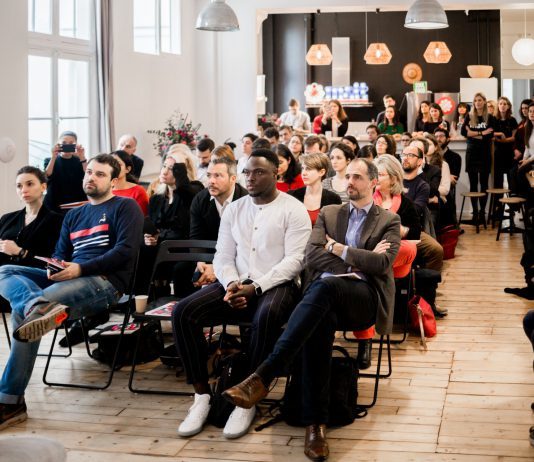
Malt and EFIP teamed up to launch the European Freelancers Survey 2018. The goal? Paint a comprehensive picture of the status of independent work across Europe and make freelancers’ voice heard!
Freelancers are a high-growing and heterogenous part of the small business population. They can be largely miscalculated and misunderstood, especially at European level. This survey is aimed to find out more about European freelancers and understand the reality of their working lives and the regulatory framework they work within.
The European Freelancers Survey will be an evidence-based yearly survey that tracks the business performance, wellbeing and economic outlook of freelancers in Europe. It will be a valuable barometer which can be used to identify trends and general freelancers’ perception of economic and social conditions in Europe.
The results will be compiled and analyzed in a report that will be published during the European Freelancers Week in October 2018.
If you’re a freelancer, complete the survey now and contribute to improving the self-employment landscape in Europe! If some of your acquaintances are freelancers, spread the word!
The post Malt and the EFIP launch the first European Freelancers Survey appeared first on Seats2meet.
August 6, 2018
Beyond coworking centers… Where is the work actually happening?
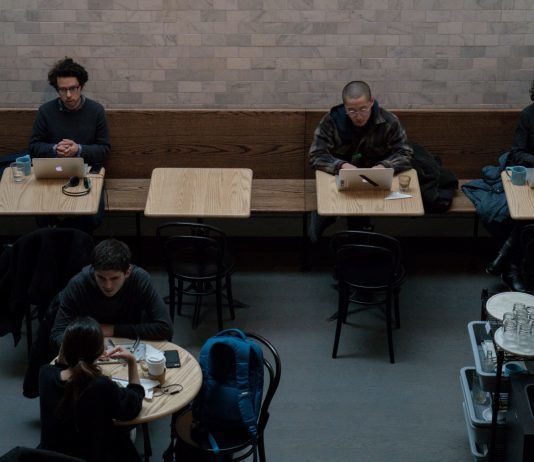
In my last blog post, I discussed a lot about what the coworking climate looks like today in America. Freelancers, entrepreneurs, and even large companies are beginning to utilize coworking centers as a means for inspiration and collaboration. However, it is important to note that the average monthly cost of renting a flexible desk in a coworking space in the U.S. is $195. This is a luxury that not everyone can afford. Apart from that, a coworking center may not be for everyone. Which begs the question, outside of coworking centers where are freelancers, remote workers and entrepreneurs conducting work?
The Third Place
A common place individual’s find themselves doing their work is at their home. In fact, in a survey of remote workers, 78% use their home as their primary place of work. However, the home can serve as a distraction. There are always things to do around the house and more than that, it can be lonely. As such, people are becoming more and more drawn to doing their work in a third place.
A third place can be defined as a place people gather outside of the first place (the home) and the second place (the workplace). Put simply, a third place acts as a “living room” of society. The concept of the third place dates back to the 16th century, when individuals gathered to discuss life in taverns and bars. In fact, the Protestant reformation was born in a third place at a local tavern in Cambridge, England. Examples of modern day third places include restaurants, parks, recreation centers, and gyms. There are many third places that naturally lend themselves to being a suitable location for individuals (such as freelancers, remote workers, and entrepreneurs) to do their work. For example, cafes, libraries, community centers, and of course coworking centers.
Cafes
When you step into your neighborhood coffeeshop, one thing you tend to notice is individuals on their laptops, busy at work. In fact, 5% of remote workers use a café as their primary place of work. Take Starbucks for example, quite honestly, they have perfected their atmosphere to attract remote workers. With free wifi, a relaxed atmosphere, and a great selection of food and drinks it is easy to see that you can be productive there. With this in mind, each person has their own needs and cafes can pose many disadvantages. For example, where does someone go if they have to take an important business call? Or, what happens if they need to have a space to invite clients to? In those cases, a café simply won’t do. You need a space that is more flexible and adaptable.
Libraries
Not only do libraries have nearly limitless resources, they also provide a calm and relaxing atmosphere. However, libraries are not always the easiest place to socialize and network. One library that has launched a new concept is The Edge located in Queensland, Australia. The Edge is an initiative by the State Library of Queensland to create a space in the library designed with collaboration and open sharing in mind. For example, the furniture is moveable and can be manipulated to fit the needs of the user. In addition, The Edge hosts a variety of workshops and presentations to foster knowledge sharing.
Unconventional Work Spaces
As the coworking industry continues to grow, individuals have sought to find spaces that differ from coworking centers or your local café. While coworking centers can provide peace and quiet, they can be quite expensive. On the other hand, cafes are free of cost (except for delicious muffin and coffee you always end up purchasing) but are not necessarily the most professional environment to conduct your business. Facing challenges similar to these, Nick Jiang and Ray Choi launched a new coworking concept entitled Birdnest. Birdnest is based in San Francisco, CA and turns underutilized spaces (such as restaurants) into makeshift offices for companies. At the cost of roughly $3 a day, the intrigue is hard to deny. Even more, restaurants are seeing close to 15% more of additional revenue. Birdnest solved the problem that many coworkers and start-ups were facing— a private, low commitment, and flexible workspace to conduct business.
Corporate Take on Third Places
Larger companies are organizations are beginning to take notice too. In response to changing work preferences, companies like Google are beginning to create spaces for their employees to recharge, be social and become inspired. The on-campus third place is becoming exceedingly more common and looks different from one company to the next. For example, Facebook has a video game room whereas Google launched an on-campus coffee shop called Coffee Lab. Regardless of its appearance, these spaces have been created to bring comfort within the four walls of a company and to increase employee productivity and engagement.
So, what does this mean?
Of course, individuals are finding spaces to work outside of cafes, libraries, community spaces and coworking centers. But these tend to be the spaces that individuals find themselves to be productive and able to connect with others as a means to collaborate. Looking into the future, the number of remote and freelance workers will continue to grow. As the number increases and the landscape for working in today’s world has changed, I am certain that we will continue to see how organizations and companies create a better work environment for their employees by incorporating elements of the third place into the office.
The post Beyond coworking centers… Where is the work actually happening? appeared first on Seats2meet.



